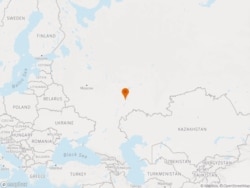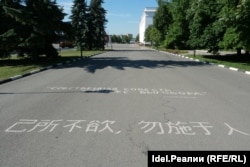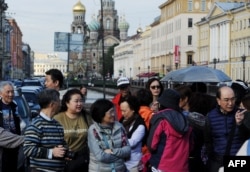ULYANOVSK, Russia -- From big gas projects to closer military cooperation and improved bilateral trade that reached a record of more than $110 billion in 2019, the China-Russia relationship has reached new heights.
But in Ulyanovsk, a region some 850 kilometers east of Moscow, a different portrait of Chinese-Russian ties is unfolding.
The city of 1.2 million -- and the wider region by the same name -- are home to a growing array of local initiatives connected to China that have been pushed against the backdrop of warming high-level ties between Beijing and Moscow.
At the local level, this has included deepening trade links, a burgeoning tourism sector, and future infrastructure deals -- including plans for a Chinese-funded highway project through Russia that is meant to connect Europe to western China.
There have been loud pronouncements from local officials about expanding ties with China and an eagerness from Chinese investors to explore opportunities across Russia.
But much cooperation in Ulyanovsk exists only on paper -- frozen due to budget issues and border restrictions brought by the COVID-19 pandemic.
Unpacking this complex dynamic is the focus of a recent series by RFE/RL's Tatar-Bashkir Service. It takes an up-close look at ties between the two countries at the ground level.
Through interviews with local officials, activists, and experts, the Ulyanovsk region is seen as a potential future location for China's economic footprint to grow in Russia.
But this development faces pushback from local residents. There are also difficulties in translating deals into real projects on the ground, despite the partnership's top-level endorsement.
"Relations with Europe and the West are in a tense state and the Russian economy, in my opinion, needs cooperation because domestic production is poorly established," says Vitaly Kuzin, a member of the Communist Party who sits in the Legislative Assembly of Ulyanovsk Oblast.
"China is a locomotive for the world economy, so our country needs to deepen its cooperation," Kuzin says.
All Roads Lead to China
Ties between China and Russia have improved markedly since 2014 when the Kremlin declared it would pivot to Asia in the wake of Western economic sanctions over Moscow's annexation of Crimea and Russia's role in the war in eastern Ukraine.
The deepening relationship is best seen in the interactions between the leaders of the two countries: Vladimir Putin and Xi Jinping.
They have met more than 30 times since 2013, with Xi even referring to the Russian president as his "best friend" during a 2019 summit.
These ties have fueled a flurry of deals since 2014, mostly connected to Chinese investments in Russian extractive resources, such as its lucrative oil and gas sector.
But in recent years, Beijing has also begun to cautiously eye other sectors. It has invested in high-tech industries and is increasingly using Russia to transport goods to and from Europe.
In Ulyanovsk, which sits on the European side of Russia, local authorities have attempted to expand their links to China.
In 2020, the first direct train from China arrived in the region. Its 53 container cars carried a mix of automobile parts and industrial equipment into Russia, then returned to China with a cargo of grain and sunflower oil.
The area is also home to a Chinese-Russian Special Economic Zone (SEZ). Founded in 2019, it received a modest investment of $1.5 million to start setting up a local technology center.
But many local officials have told RFE/RL's Tatar-Bashkir Service that restrictions brought by the pandemic have frozen this nascent local-level cooperation.
In February 2020, Russia enacted strict border measures with China to curb the coronavirus outbreak. Beijing also restricted movement into China following several local outbreaks linked to travelers arriving from Russia.
"Travel on this railroad has stopped since the start of the pandemic and the closure of the borders, and has not started since then," Tatyana Fadeeva, a spokesperson for the Ulyanovsk Region Development Corporation, told RFE/RL's Tatar-Bashkir Service. "We don't have any information on when the movement will resume."

Vladimir Kazantsev, an independent sociologist in Ulyanovsk, says the frozen transport links, as well as the obstacles and limits on bringing in large sums of Chinese investment, highlight the disparity between deepening Russia-China political and military cooperation and the realities for more remote regions.
"It is unprofitable to build production [in Russia] in order to bring finished products to China," Kazantsev told RFE/RL. "The economics don't add up."
'Red Tourism'
One area that has seen extended growth in recent years is tourism between China and the Ulyanovsk region. A growing number of Chinese visitors are traveling to the area due to its importance in history as the birthplace of Soviet leader Vladimir Lenin.
So-called "red tourism" within China, where tourists visit locations with historic significance for Chinese communism, has been a priority promoted by Beijing over the last several decades.
In 2014, formal cooperation between the Chinese and Russian governments was established to bring more tourists to Russia.
Due to its connections to Lenin, Ulyanovsk has become a focal point for this type of tourism.
During a visit to Ulyanovsk in 2013, the then-chairman of the China National Tourism Administration Shao Qiwei referred to the city as "the beginning of China's red history."
Since 2015, the number of Chinese tourists visiting Ulyanovsk has increased annually by 20 to 30 percent, according to the local tourism board.
Overall figures remain modest, however, with an estimated 7,000 Chinese visitors passing through Ulyanovsk on tours along Russia's so-called "red route" -- which includes historic sites in Kazan, St. Petersburg, and Moscow, and is expected to expand to Yekaterinburg, Perm, Samara, Ufa, and Krasnoyarsk.
Expanding those links remains difficult because the pandemic has largely frozen the growth of tourism from China to the region. In fact, official statistics show an 86 percent drop in total tourism since 2020.
Despite these obstacles, many local officials see strong potential in communist-linked tourism from China and are pushing for more investment in the sector.
Aleksei Kurinny, a Communist Party member of the Russian State Duma from the Ulyanovsk region, told RFE/RL that, while investment with China is difficult to attract, tourism to the area has untapped potential.
"Investing in the tourism industry and attracting more tourists from China is not yet fully developed," Kurinny said. "We are considering moving in this direction as the main area for cooperation with China."
Navigating A New Era
This leaves deepening cooperation with China in the Ulyanovsk region at a difficult crossroads as ties continue to blossom between the Kremlin and Beijing.
Kurinny is apprehensive about how much direct investment his region can attract from China.
He says that he is aiming to attract projects focused on industries higher up in the supply chain, pointing to how his party moved against plans to build a Chinese cement plant in Ulyanovsk due to environmental concerns.
"The region today is interested in high-tech production, something that can contribute to its high-tech development and not simply aim to dig something up," Kurinny said.
It's for these reasons that Igor Toporkov, an Ulyanovsk-based human rights activist, is skeptical about the area becoming a regional hub for Chinese economic growth.
"There are some isolated projects, but I don't think there will be any big Chinese expansion to the Ulyanovsk region," Toporkov told RFE/RL.
Still, there are attempts to move large projects forward.
In November 2020, plans were announced to build a highway through Ulyanovsk that would serve as an important transit route for shipping goods between China and Europe through Russia.
The project has received high-level backing. But RFE/RL found there has been little public discussion about the plans and several legal procedures have been bypassed.
That has raised concerns about environmental risks during construction and how residents close to the planned highway route could be impacted.
"Due to the lack of public discussions, the rights of residents of those settlements near where the road would pass are being violated," says Aleksandr Nikolaev, a lawyer from nearby Chuvashia who focuses on transport issues.
















